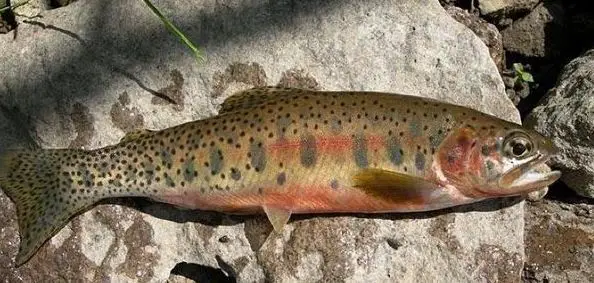This post was last updated on May 2nd, 2014 at 07:54 pm
Westslope Cutthroat Trout (Oncorhynchus clarki lewisi)
 The Westslope Cutthroat trout is not a terribly large species. Its average size is 6 to 16 inches, depending on habitat, but very rarely exceed 18 inches. This is a species of concern because of its hybridization with the rainbow trout and the Yellowstone strain of cutthroat throughout much of its range. These trout tend to live a maximum of 8 years of age. They prefer to eat mainly insects and plankton unlike many of the cutthroat varieties.
The Westslope Cutthroat trout is not a terribly large species. Its average size is 6 to 16 inches, depending on habitat, but very rarely exceed 18 inches. This is a species of concern because of its hybridization with the rainbow trout and the Yellowstone strain of cutthroat throughout much of its range. These trout tend to live a maximum of 8 years of age. They prefer to eat mainly insects and plankton unlike many of the cutthroat varieties.
Spawning
The Westslope Cutthroat will usually only spawn in rivers like many other trout species. It will ascend the rivers and usually breed in the spring when the water temperature is around 10 degrees Celsius. The Westslope Cutthroat can either live in lakes, rivers, or a combination of both. They will often travel hundreds of miles in order to breed in a particular area.
Locations
The Westslope Cutthroat has some of its strongest populations in Glacier National Park in Montana. Westslopes are native in northern Idaho and the upper Columbia system in BC and many northern tributaries of the Snake River. They are not present in the southern snake river flowing through Wyoming and Much of Idaho. This area is known for the Yellowstone Cutthroat and the Snake river fine-spotted cutthroat strains.
The Montana Department of Fish, Wildlife and Parks at its Anaconda hatchery, have a pure strain brood stock of the westslope cutthroat. They use these for stocking in certain areas that have low natural reproduction and because it is good to keep genetically pure strains in isolation. The Westslope cutthroat is a sensitive species, they have suffered degradation and habitat loss due to poor choices by people in the past. With the recent efforts hopefully we can help the native westslopes make a comeback and restore it to more of its original home range throughout the west.
